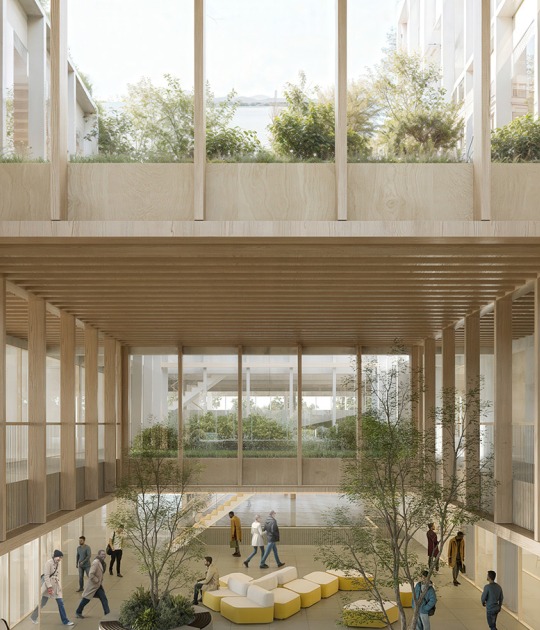PRIMER PREMIO.
Visiting the amazon it’s a journey not a day trip. The Amazon cannot be reduced to just one specific place, instead we chose to adapt ourselves to the richness of the region and propose a system that can me implemented throughout all the river.
Conceived as a network of preinstalled steel ropes each one of them work as “stations” –refuges- one journey distant from each other. Ropes are anchored to nearby tree trunks at both sides of the river. Tents are hanged and raised for sleeping or contemplation.
The Hang-And-See Tent, levitating above the river lets the traveller to enjoy the Amazon in a never-experienced-before manner, diminishing the risk of being attacked or bite achieving the best possible views, a unique experience.
SEGUNDO PREMIO.
Designing an observatory for the Amazonian Rainforest, our proposal is driven by the idea of developing a new principle of “sustainable tourism” rather than creating just an architectural object.
Our main focus for the design is to create a eco-friendly tour along a arranged path through the forest. Visitors will be introduced into a huge variety of Amazon’s flora and fauna and get in touch as close as possible with a minimum of physical impact.
The route leads the participants, beginning from the starting point, a Pier at the Amazon river to several checkpoints. Those checkpoints, called ‘cabana’ (portuguese, kind of a ‘gazebo’) provide information about the Amazon region. Through observation spots precious and rare animals can be observed. After a long way through wild forest resting points give shelter and protection for the typical heavy rain-showers, or easing the heat and humidity through air circulation. Visitors are getting educated in the cycle of the rainforest without disturbing the peaceful environment.
The goal was to design a self maintaining system, adaptable to different conditions and to be assembled by traditional crafting techniques. All crafted parts are sustainably prefabricated, modestly chosen from the local region, and gently assembled. Therefore visitors can experience traditional culture in a modern setting.
Despite the fact that each cabana provides different functions there are some major similarities which all have in common.
For material management regarding efficiency and sustainability the concept is following: Levitated from the ground, to keep water and small mammals out, enable a improved circulation.
The main construction are build with on sight material - which determines there shape and size. Artichoke- like tiling protects against rain and sun.
The facade tiles and the floor finish are woven basket-structures based on the local crafting method of the indigenous community, these structure are durable and easy to substitute.
In case of legacy the structures won’t influence the nature negatively but will be overcome by the vegetation and be transferred into the natural cycle.
TERCER PREMIO.
Al plantearme por primera vez un observatorio en un ambiente como el Amazonas me di cuenta de que el término ‘observar’ se quedaría corto en dicha localización. Por esta razón, NOA SEAL no es un simple observatorio. NOA SEAL es un laboratorio, donde no solo se observa, sino que también se descubre, estudia y experimenta con el exterior. El edificio será una cápsula de reconocimiento del terreno. Será una herramienta más, y por lo tanto, no será el fin último del proyecto; sino un medio, una máquina.
Tras estudiar en profundidad la zona del Amazonas, solo por su gran inmensidad, es imposible elegir la coordenada exacta en la que se debería localizar un observatorio. Por eso, NOA es una cápsula que no está determinada por una localización concreta, sino por muchas. Generado con materiales flexibles y ligeros la ubicación de la cápsula se elegirá por el usuario, que podrá cambiar según las necesidades del estudio o de la observación.
NOA SEAL LAB constará de dos partes diferenciadas por sus materiales y su metodología a la hora de la construcción. El proceso constructivo nos permite llegar a zonas remotas al mismo tiempo que aparece instantáneamente en el lugar.
Una de las intenciones de este proyecto es conseguir que cada uno de los ecosistemas del Amazonas no se vea alterado por la presencia de una arquitectura en el suelo. A través de la creación de los postes conseguimos una vista privilegiada de la naturaleza, no solo por la altura, sino porque la fauna y la flora pueden continuar desarrollándose a nuestros pies. En la situación acuática nos permite adentrarnos en el mismo curso del agua. La situación de la pradera nos permite tener una gran visión de la planicie. Y la situación de la selva nos concede una relación con los árboles y la naturaleza mucho más cercana.




























